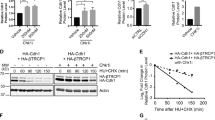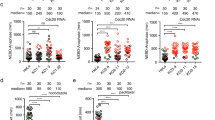Abstract
In budding yeast, DNA damage in G1 activates a Rad9-dependent checkpoint that targets the cyclin-dependent kinase (CDK) Cdc28 to delay G1 exit. After a transient arrest, cells may enter S phase before completing DNA repair. We used genetic analysis to identify the stress-responsive CDK Pho85, the cyclin Pho80 and the targeted transcription factors Pho4 and Swi5 as determinants of G1 checkpoint adaptation. Consistent with opposing roles for the Cdc28 inhibitor Sic1 in blocking G1 exit and Pho85 in targeting Sic1 for proteolysis, mutation of Sic1 curtails G1 checkpoint delay, whereas Pho85 inhibition after DNA damage promotes Sic1 stability. G1 checkpoint delay in mutants lacking both Sic1 and Pho4 is independent of Pho85 activity. These data establish a G1 checkpoint adaptation pathway where Pho85 mediates Pho4 downregulation and Sic1 degradation to release Cdc28 activity and promote onset of S phase.
This is a preview of subscription content, access via your institution
Access options
Subscribe to this journal
Receive 12 print issues and online access
$189.00 per year
only $15.75 per issue
Buy this article
- Purchase on Springer Link
- Instant access to full article PDF
Prices may be subject to local taxes which are calculated during checkout





Similar content being viewed by others
References
Bartek, J. & Lukas, J. Mammalian G1- and S-phase checkpoints in response to DNA damage. Curr. Opin. Cell Biol. 13, 738–747 (2001).
Lukas, J., Lukas, C. & Bartek, J. Mammalian cell cycle checkpoints: signalling pathways and their organization in space and time. DNA Repair (Amst.) 3, 997–1007 (2004).
Royds, J.A. & Iacopetta, B. p53 and disease: when the guardian angel fails. Cell Death Differ. 13, 1017–1026 (2006).
Lowndes, N.F. & Murguia, J.R. Sensing and responding to DNA damage. Curr. Opin. Genet. Dev. 10, 17–25 (2000).
Kolodner, R.D., Putnam, C.D. & Myung, K. Maintenance of genome stability in Saccharomyces cerevisiae. Science 297, 552–557 (2002).
Rouse, J. & Jackson, S.P. Interfaces between the detection, signaling, and repair of DNA damage. Science 297, 547–551 (2002).
Melo, J. & Toczyski, D. A unified view of the DNA-damage checkpoint. Curr. Opin. Cell Biol. 14, 237–245 (2002).
Branzei, D. & Foiani, M. The DNA damage response during DNA replication. Curr. Opin. Cell Biol. 17, 568–575 (2005).
Longhese, M.P., Clerici, M. & Lucchini, G. The S-phase checkpoint and its regulation in Saccharomyces cerevisiae. Mutat. Res. 532, 41–58 (2003).
Wysocki, R. et al. Role of Dot1-dependent histone H3 methylation in G1 and S phase DNA damage checkpoint functions of Rad9. Mol. Cell. Biol. 25, 8430–8443 (2005).
Sidorova, J.M. & Breeden, L.L. Rad53-dependent phosphorylation of Swi6 and down-regulation of CLN1 and CLN2 transcription occur in response to DNA damage in Saccharomyces cerevisiae. Genes Dev. 11, 3032–3045 (1997).
Sidorova, J.M. & Breeden, L.L. Rad53 checkpoint kinase phosphorylation site preference identified in the Swi6 protein of Saccharomyces cerevisiae. Mol. Cell. Biol. 23, 3405–3416 (2003).
Barberis, M. et al. The yeast cyclin-dependent kinase inhibitor Sic1 and mammalian p27Kip1 are functional homologues with a structurally conserved inhibitory domain. Biochem. J. 387, 639–647 (2005).
Harper, J.W. A phosphorylation-driven ubiquitination switch for cell-cycle control. Trends Cell Biol. 12, 104–107 (2002).
Westmoreland, T.J. et al. Cell cycle progression in G1 and S phases is CCR4 dependent following ionizing radiation or replication stress in Saccharomyces cerevisiae. Eukaryot. Cell 3, 430–446 (2004).
Carroll, A.S. & O'Shea, E.K. Pho85 and signaling environmental conditions. Trends Biochem. Sci. 27, 87–93 (2002).
Moffat, J., Huang, D. & Andrews, B. Functions of Pho85 cyclin-dependent kinases in budding yeast. Prog. Cell Cycle Res. 4, 97–106 (2000).
Toh-e, A. & Nishizawa, M. Structure and function of cyclin-dependent Pho85 kinase of Saccharomyces cerevisiae. J. Gen. Appl. Microbiol. 47, 107–117 (2001).
Knapp, D., Bhoite, L., Stillman, D.J. & Nasmyth, K. The transcription factor Swi5 regulates expression of the cyclin kinase inhibitor p40SIC1. Mol. Cell. Biol. 16, 5701–5707 (1996).
Nishizawa, M., Kawasumi, M., Fujino, M. & Toh-e, A. Phosphorylation of sic1, a cyclin-dependent kinase (Cdk) inhibitor, by Cdk including Pho85 kinase is required for its prompt degradation. Mol. Biol. Cell 9, 2393–2405 (1998).
Carroll, A.S., Bishop, A.C., DeRisi, J.L., Shokat, K.M. & O'Shea, E.K. Chemical inhibition of the Pho85 cyclin-dependent kinase reveals a role in the environmental stress response. Proc. Natl. Acad. Sci. USA 98, 12578–12583 (2001).
Fitz Gerald, J.N., Benjamin, J.M. & Kron, S.J. Robust G1 checkpoint arrest in budding yeast: dependence on DNA damage signaling and repair. J. Cell Sci. 115, 1749–1757 (2002).
Bishop, A.C. et al. A chemical switch for inhibitor-sensitive alleles of any protein kinase. Nature 407, 395–401 (2000).
Flattery-O'Brien, J.A. & Dawes, I.W. Hydrogen peroxide causes RAD9-dependent cell cycle arrest in G2 in Saccharomyces cerevisiae whereas menadione causes G1 arrest independent of RAD9 function. J. Biol. Chem. 273, 8564–8571 (1998).
Pellicioli, A. & Foiani, M. Signal transduction: how rad53 kinase is activated. Curr. Biol. 15, R769–R771 (2005).
Lewis, L.K. & Resnick, M.A. Tying up loose ends: nonhomologous end-joining in Saccharomyces cerevisiae. Mutat. Res. 451, 71–89 (2000).
Javaheri, A. et al. Yeast G1 DNA damage checkpoint regulation by H2A phosphorylation is independent of chromatin remodeling. Proc. Natl. Acad. Sci. USA (in the press).
Beranek, D.T. Distribution of methyl and ethyl adducts following alkylation with monofunctional alkylating agents. Mutat. Res. 231, 11–30 (1990).
Lundin, C. et al. Methyl methanesulfonate (MMS) produces heat-labile DNA damage but no detectable in vivo DNA double-strand breaks. Nucleic Acids Res. 33, 3799–3811 (2005).
Choy, J.S. & Kron, S.J. NuA4 subunit Yng2 function in intra-S-phase DNA damage response. Mol. Cell. Biol. 22, 8215–8225 (2002).
Lewis, L.K., Kirchner, J.M. & Resnick, M.A. Requirement for end-joining and checkpoint functions, but not RAD52-mediated recombination, after EcoRI endonuclease cleavage of Saccharomyces cerevisiae DNA. Mol. Cell. Biol. 18, 1891–1902 (1998).
Lewis, L.K., Westmoreland, J.W. & Resnick, M.A. Repair of endonuclease-induced double-strand breaks in Saccharomyces cerevisiae: essential role for genes associated with nonhomologous end-joining. Genetics 152, 1513–1529 (1999).
Measday, V., McBride, H., Moffat, J., Stillman, D. & Andrews, B. Interactions between Pho85 cyclin-dependent kinase complexes and the Swi5 transcription factor in budding yeast. Mol. Microbiol. 35, 825–834 (2000).
Huang, D., Moffat, J. & Andrews, B. Dissection of a complex phenotype by functional genomics reveals roles for the yeast cyclin-dependent protein kinase Pho85 in stress adaptation and cell integrity. Mol. Cell. Biol. 22, 5076–5088 (2002).
Winkler, A. et al. Heat stress activates the yeast high-osmolarity glycerol mitogen-activated protein kinase pathway, and protein tyrosine phosphatases are essential under heat stress. Eukaryot. Cell 1, 163–173 (2002).
Rep, M. et al. The Saccharomyces cerevisiae Sko1p transcription factor mediates HOG pathway-dependent osmotic regulation of a set of genes encoding enzymes implicated in protection from oxidative damage. Mol. Microbiol. 40, 1067–1083 (2001).
Bilsland, E., Molin, C., Swaminathan, S., Ramne, A. & Sunnerhagen, P. Rck1 and Rck2 MAPKAP kinases and the HOG pathway are required for oxidative stress resistance. Mol. Microbiol. 53, 1743–1756 (2004).
Lawrence, C.L., Botting, C.H., Antrobus, R. & Coote, P.J. Evidence of a new role for the high-osmolarity glycerol mitogen-activated protein kinase pathway in yeast: regulating adaptation to citric acid stress. Mol. Cell. Biol. 24, 3307–3323 (2004).
Panadero, J., Pallotti, C., Rodriguez-Vargas, S., Randez-Gil, F. & Prieto, J.A. A downshift in temperature activates the high osmolarity glycerol (HOG) pathway, which determines freeze tolerance in Saccharomyces cerevisiae. J. Biol. Chem. 281, 4638–4645 (2006).
Escote, X., Zapater, M., Clotet, J. & Posas, F. Hog1 mediates cell-cycle arrest in G1 phase by the dual targeting of Sic1. Nat. Cell Biol. 6, 997–1002 (2004).
Haghnazari, E. & Heyer, W.D. The Hog1 MAP kinase pathway and the Mec1 DNA damage checkpoint pathway independently control the cellular responses to hydrogen peroxide. DNA Repair (Amst.) 3, 769–776 (2004).
Doolin, M.T., Johnson, A.L., Johnston, L.H. & Butler, G. Overlapping and distinct roles of the duplicated yeast transcription factors Ace2p and Swi5p. Mol. Microbiol. 40, 422–432 (2001).
Aerne, B.L., Johnson, A.L., Toyn, J.H. & Johnston, L.H. Swi5 controls a novel wave of cyclin synthesis in late mitosis. Mol. Biol. Cell 9, 945–956 (1998).
Sancar, A., Lindsey-Boltz, L.A., Unsal-Kacmaz, K. & Linn, S. Molecular mechanisms of mammalian DNA repair and the DNA damage checkpoints. Annu. Rev. Biochem. 73, 39–85 (2004).
Li, L. & Zou, L. Sensing, signaling, and responding to DNA damage: organization of the checkpoint pathways in mammalian cells. J. Cell. Biochem. 94, 298–306 (2005).
Garber, P.M., Vidanes, G.M. & Toczyski, D.P. Damage in transition. Trends Biochem. Sci. 30, 63–66 (2005).
Nilssen, E.A. et al. Germinating fission yeast spores delay in G1 in response to UV irradiation. BMC Cell Biol. 5, 40 (2004).
Cruz, J.C. & Tsai, L.H. A Jekyll and Hyde kinase: roles for Cdk5 in brain development and disease. Curr. Opin. Neurobiol. 14, 390–394 (2004).
Zhang, J., Krishnamurthy, P.K. & Johnson, G.V. Cdk5 phosphorylates p53 and regulates its activity. J. Neurochem. 81, 307–313 (2002).
Hamdane, M. et al. p25/Cdk5-mediated retinoblastoma phosphorylation is an early event in neuronal cell death. J. Cell Sci. 118, 1291–1298 (2005).
Thomas, B.J. & Rothstein, R. The genetic control of direct-repeat recombination in Saccharomyces: the effect of rad52 and rad1 on mitotic recombination at GAL10, a transcriptionally regulated gene. Genetics 123, 725–738 (1989).
Longtine, M.S. et al. Additional modules for versatile and economical PCR-based gene deletion and modification in Saccharomyces cerevisiae. Yeast 14, 953–961 (1998).
Acknowledgements
We dedicate this work in fond memory of our colleague, Cora Styles. We thank A. Hauser for technical assistance, P. Shah and D. Bishop for guidance with CHEF analysis and K. Shokat and E. O'Shea for generously sharing strains. This work was supported by grant R01 GM60443 from the US National Institutes of Health (S.J.K.) and grant PBZ-Min-015/P05/2004 from the Polish Ministry of Education and Science (R.W.). A.J. was supported by the University of Chicago Medical Scientist Training Program and an American Heart Association Greater Midwest predoctoral fellowship, K.K. by the University of Chicago's US National Institutes of Health Cancer Biology Training Grant and S.J.K. by a Leukemia & Lymphoma Society Scholar award.
Author information
Authors and Affiliations
Contributions
R.W. and A.J. conceived, performed and analyzed experiments and cowrote the manuscript; K.K. and F.S. performed and analyzed experiments; S.J.K. conceived and analyzed experiments and edited the manuscript.
Corresponding author
Ethics declarations
Competing interests
The authors declare no competing financial interests.
Rights and permissions
About this article
Cite this article
Wysocki, R., Javaheri, A., Kristjansdottir, K. et al. CDK Pho85 targets CDK inhibitor Sic1 to relieve yeast G1 checkpoint arrest after DNA damage. Nat Struct Mol Biol 13, 908–914 (2006). https://doi.org/10.1038/nsmb1139
Received:
Accepted:
Published:
Issue Date:
DOI: https://doi.org/10.1038/nsmb1139
This article is cited by
-
The CDK Pho85 inhibits Whi7 Start repressor to promote cell cycle entry in budding yeast
EMBO Reports (2024)
-
Yeast Cip1 is activated by environmental stress to inhibit Cdk1–G1 cyclins via Mcm1 and Msn2/4
Nature Communications (2017)
-
Life in the midst of scarcity: adaptations to nutrient availability in Saccharomyces cerevisiae
Current Genetics (2010)



